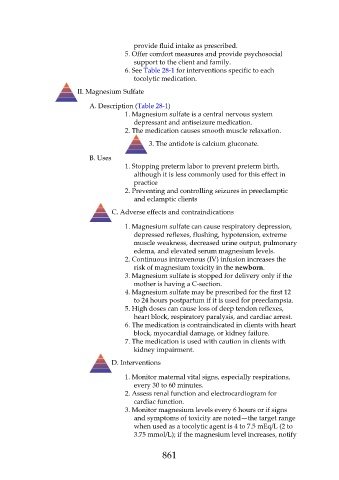Page 861 - Saunders Comprehensive Review For NCLEX-RN
P. 861
provide fluid intake as prescribed.
5. Offer comfort measures and provide psychosocial
support to the client and family.
6. See Table 28-1 for interventions specific to each
tocolytic medication.
II. Magnesium Sulfate
A. Description (Table 28-1)
1. Magnesium sulfate is a central nervous system
depressant and antiseizure medication.
2. The medication causes smooth muscle relaxation.
3. The antidote is calcium gluconate.
B. Uses
1. Stopping preterm labor to prevent preterm birth,
although it is less commonly used for this effect in
practice
2. Preventing and controlling seizures in preeclamptic
and eclamptic clients
C. Adverse effects and contraindications
1. Magnesium sulfate can cause respiratory depression,
depressed reflexes, flushing, hypotension, extreme
muscle weakness, decreased urine output, pulmonary
edema, and elevated serum magnesium levels.
2. Continuous intravenous (IV) infusion increases the
risk of magnesium toxicity in the newborn.
3. Magnesium sulfate is stopped for delivery only if the
mother is having a C-section.
4. Magnesium sulfate may be prescribed for the first 12
to 24 hours postpartum if it is used for preeclampsia.
5. High doses can cause loss of deep tendon reflexes,
heart block, respiratory paralysis, and cardiac arrest.
6. The medication is contraindicated in clients with heart
block, myocardial damage, or kidney failure.
7. The medication is used with caution in clients with
kidney impairment.
D. Interventions
1. Monitor maternal vital signs, especially respirations,
every 30 to 60 minutes.
2. Assess renal function and electrocardiogram for
cardiac function.
3. Monitor magnesium levels every 6 hours or if signs
and symptoms of toxicity are noted—the target range
when used as a tocolytic agent is 4 to 7.5 mEq/L (2 to
3.75 mmol/L); if the magnesium level increases, notify
861

